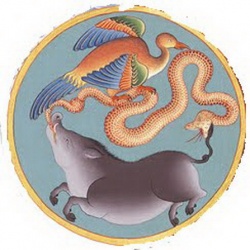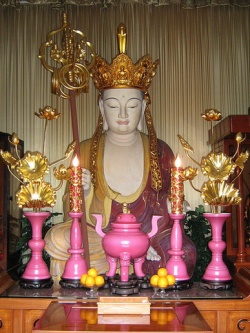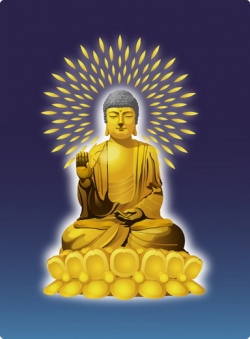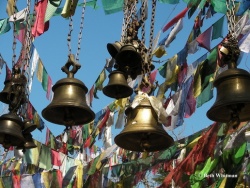Mahasamghika
Doctrines
The adherents of the self -styled ‘Majority Community’ or ‘Universal Assembly’, a school of Buddhism which originated in the schism with the Sthaviras that occured after the Second Council (see Council of Vaiśālī) and possibly just prior to the Third Council (see Council of Pāṭaliputra I).
The dispute that led to this schism seems to have largely concerned with interpretation of the Vinaya , in respect of which one side took a more liberal approach. A degree of doctrinal difference also seems to have been involved concerning disagreements over the nature of an Arhat (see Mahādeva ).
This school went on to become one of the most successful and influential forms of Buddhism in India , giving rise to several subschools in later years such as the Ekavyāvahārika, the Lokottara-vāda, and the Bahuśrutīya.
Some of the teachings of this school concerning the nature of Buddhas and Bodhisattvas have features in common with Mahāyāna
concepts, but since there is no evidence of innovation by the Mahāsaṃghikas in this respect before the rise of the Mahāyāna, in the view of some scholars , such elements should be ascribed to Mahāyāna influence.
According to this view there is thus not much likelihood that the Mahāsaṃghika school played a part in the formation of the Mahāyāna before the
latter emerged as a distinct entity. Other scholars see evidence for the converse in the formation of certain Mahāyāna sūtras, such as the Nirvāṇa Sūtra.
The Mahasamghika school (`those Belonging to the Universal Sangha ') represents one of the earliest systematic interpretations of Buddhist doctrine . Very little material on the fraternity has survived and we can only piece together their doctrines from sources preserved mainly in Chinese .
Although regarded as a non-Mahayana school the Mahasamghika had a view of the Buddha which looks characteristically Mahayana . Indeed, what remains of the Mahasamghika canon incorporates elements of, and has been incorporated by, the Mahayana .
An example of this is the Mahavastu sutra of the Mahasamghika which, like many Mahayana sutras , describes the stages through which a Bodhisattva passes on the way to enlightenment .
The Mahasamghikas regarded the Buddha as supramundane, beyond all impurity and restriction. Although he is real, his human life was illusory and was lived for the benefit of sentient beings . Therefore his lives, even before his final miraculous human birth, transcended unenlightened knowledge and his human quest for enlightenment was illusory .
Because this is the case all the words he spoke were concerned with the transcendent and it is up to listeners to understand them rightly according to
their capabilities. Unlike the Sthaviravadins (the elders) the Mahasanghikas accepted five points put forward by a monk named Mahadeva who argued that arhats were still subject to nocturnal emissions as a result of erotic dreams ;
that, though spiritually enlightened , they were still subject to ignorance on worldly matters; that they were subject to doubt ; that they could still acquire information from other people; and that when entering the enlightened state they may speak certain words, for example "dukkha !". These points, which represented a lowering in the status of an arhat , may also have been an attempt to re-present arhatship as an attainable goal.
History
The Mahasamghika school maintained the view of the majority of the Buddhist Sangha when it first divided from the Sthaviravadins either
at the second Buddhist council at Vaisali , held about seventy years after the Buddha 's death or, more likely, at a later meeting at Pataliputra in about 308BCE.
Three possible reasons for this division have been advanced, based on accounts preserved by various later schools. One possible reason was a division over matters of doctrine which centres on Mahadeva's five points.
Although Mahadeva's points were significant for future doctrinal development, they are unlikely to have been the cause for this early division since schisms (sanghabeda) generally resulted from differences in the vinaya , the disciplinary code. According to some sources, the Sthaviravadins divided from the Mahasamghika in order to reestablish adherence to the vinaya after it had become lax.
Mahasamghika sources however record that the Sthaviravadin elders were attempting to introduce minor rules which had not been laid down at the original vinaya recitation at the first Council and were thereby straying unnecessarily from the tradition .
This interpretation is backed up by the fact that the Mahasamghika vinaya , which has survived, is thought to be very early and is indeed the shortest surviving version of the vinaya .
We know that the Mahasanghikas later subdivided into two fraternities; the Ekavyavhàrika in the north and the Caitra in the south, although sources are insufficient to provide details of these developments.
Symbols
There is no textual or inscriptional evidence to indicate that the school had a distinct symbol system.
Adherents
The Mahasamghika school and much of its canon was destroyed during the Muslim invasion of Northern India in the twelfth century. However, the influence of the Mahasamghika survives through the admission of its sutras to the Mahayana canon, particularly in its Chinese recension.
Headquarters/ Main Centre
The school was very strong in Magadha , at Pataliputra, and there is inscriptional evidence of its presence in Mathura from 120 BCE. At a later date it established a centre in Southern India in the Guntur district.
One of the earliest of the non-Mahāyāna Buddhist "sects" (the so-called Eighteen Schools of Hīnayāna Buddhism ), the Mahāsāṃghika has been generally considered the precursor of Mahāyāna.
However, although the Mahāsāṃghika and its subschools espoused many of the most radical views later attributed to the "Great Vehicle," other factors and early schools also contributed to the development of this movement.
Early Development
Traditional accounts differ on the occasion and reason for the schism that gave rise to the Mahāsāṃghika. Some accounts claim that the
Mahāsāṃghika separated from the Sthavira at the time of the Second Buddhist Council (Vaiśālī, c. 340 bce), others, that it occurred during a third council (sometimes confused with the Third Council held at Pāṭaliputra under King Aśoka, 244 bce).
The reasons for the schism have also been much debated.
It is agreed that the split was motivated by matters of monastic discipline , but scholars disagree on the precise issues at stake. Most Western scholars are inclined to accept that the Mahāsāṃghika represented the more lax position in matters of discipline .
Less common is the position of those who would claim the opposite, pointing to the fact that the Mahāsāṃghika had a very conservative Vinaya and that its Prātimokṣa was as strict as that of other Hīnayāna schools.
It seems therefore unlikely that laxness in monastic regulations was the motive for the split.
Moreover, recent scholarship tends to distinguish the dispute that provoked the Second Council , which ended in reconciliation in the order, from a dispute that probably occurred shortly thereafter (anywhere between sixteen and sixty years later).
It was this latter dispute that produced the schism that divided the Hīnayāna schools into its two major camps, the Sthaviras and the Mahāsāṃghikas.
Be that as it may, it seems obvious that the Mahāsāṃghika criticized the arhat ideal and exalted the image of the Buddha , turning the historical life of the founder into an event of secondary importance and the arhat ideal into an inferior goal. In this
sense they were making an argument against tradition , and whatever the significance of their Vinaya may be, their doctrinal positions were clearly innovative.
Literature
The Mahāsāṃghika tendency to innovate can be seen also in the content and structure of their Tripiṭaka.
Although in its early stages it is believed to have been comprised of only three parts (Sūtra, Vinaya , and Abhidharma ), the Sūtra Piṭaka was later expanded so that the Kṣudraka Āgama became a separate Piṭaka called Saṃyukta Piṭaka.
The most characteristic doctrine of the Mahāsāṃghika group are the famous "Five Points of Mahādeva" (sometimes attributed to a certain Bhadra), an attack on the arhat that has been the object of at least two interpretations: it can be regarded as an argument for more lax moral standards or it can be seen as an indirect way of arguing for the value of the bodhisattva ideal .
These five points are
- that an arhat can be seduced by another (para-upahṛta—meaning that he can have nocturnal emissions accompanied by an erotic dream );
- that ignorance (ajñāna) is not totally absent in an arhat (his spiritual insight does not give him knowledge of profane matters);
- that an arhat can be surpassed by another (para-vitīrṇa—a term of obscure meaning); and
- that an arhat can enter the higher stages of the path by uttering a phrase (vacibheda) such as "Oh, sorrow!"
The exact meaning of these doctrines is far from obvious. Even the general intent is not transparent; one may ask if the Five Points imply that the arhat is more human than he was thought to be in other schools, or that he is weaker than others believe.
Also characteristic of the Mahāsāṃghika is the belief that there are many Buddhas in all of the ten directions and at all times in the past, the present, and the future. In this they differ from more conservative Buddhists who believe that a Buddha is a rare phenomenon .



